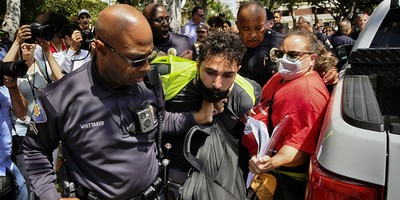Ohio has a political-identity crisis. Is it a “blue state,” as demonstrated by Democrats’ statewide wins in 2006 and 2008, or a “red state” that is just fed up with the behavior of its former Republican elected officials?
“Well, it's more like an orange state,” said Bert Rockman, a political scientist from Purdue University.
Ohio, Rockman explains, is mostly up for grabs: “Through gerrymandering – and, yes, both parties do it – Republicans had for some time a lock on the state legislature and, therefore, a lock on the state's congressional delegation.”
That's changed some, precipitated by the misfortunes during Republican Gov. Bob Taft’s administration and by the difficult economic climate that Ohio, like other industrial Midwestern states, has suffered.

Democrats do well in the cities; Republicans do well in small towns and rural parts of the state. The suburbs are up for grabs; they lean more Republican around Cincinnati with more Democratic near Columbus.
Look at Columbus for how the state will go: It is a formerly Republican middle-class city that is now mainly Democratic; its typically well-off suburbs are still mainly Republican but trending lately toward Democrats.
“Generally speaking,” Rockman says, “despite much malarkey about Reagan Democrats, the Democrats have consistently held onto their working-class base” in the state.
Recommended
This week, a former Republican congressman from Ohio, John Kasich, announced he will take on Democratic Gov. Ted Strickland next year. The ebb-and-flow of that race in many ways will reflect the mood of the country and whether or not the Democrats’ revolution of 2008 has legs.
Strickland’s counterpart in Pennsylvania, Gov. Ed Rendell, is a great admirer of Kasich (a Pittsburgh native) and calls him one of his favorite Republicans. Yet he says, predictably, that Strickland deserves to be re-elected.
“Ted has done a fabulous job in Ohio,” Rendell said, explaining that a governor’s role is to create an environment for job development, job growth and job retention – three marks he says Strickland has hit.
Statewide, Strickland is better-known. He comes from southern Ohio and is, as Democrats go, fairly conservative – though undoubtedly less so than Kasich.
Rockman anticipates this will be a real horserace: “A lot may depend upon whether voters think well of the current presidential administration … as well as what they think of Strickland, who still seems to be doing okay.
“Kasich will be a formidable opponent. … (He’s) an adept compromiser, across party lines on certain issues. If he doesn't make it, it will not be for lack of effort.”
Democratic strategist John Lapp of Ralston-Lapp sees it differently. “Look, you have a Republican field of throwbacks; Kasich is easily identifiable as a (Newt) Gingrich throwback.”
He believes Ohio Democrats have the better bench now and in the future, making Ohio a reliable blue state for perhaps generations.
The country is at a particular moment in time in which people are becoming more comfortable with a protective – and inevitably bigger – government than with a smaller one, which breeds longevity for Democrats.
Yet with big-government love comes the fact that someone has to pay for it, meaning taxpayers.
So what strengths do Strickland and Kasich bring to their showdown?
An ordained minister, Strickland is non-ideological; he won traditional Democratic constituencies in northeast Ohio and the big cities but also did well in Ohio’s Appalachian region. His appeal seemed broad in 2006, but that could have resulted in part from the scandals unfolding within Taft's administration.
Kasich, on the other hand, has dual appeal: A son of working-class parents, he is very tight on fiscal matters and pretty conventionally Republican in rhetoric. Tremendously buoyant, he has a genuine empathy for working people and the insecurities afflicting industrial workers.
Republican Minority Leader John Boehner, R-Ohio, told the Trib that Kasich’s candidacy will instantly instigate a debate over how Ohio is losing people, losing industry and raising taxes and how Ohioans must reverse that process.
“John Kasich was a reformer long before it became popular,” Boehner said. “He understands what needs to be done to enact real change in Ohio.”
How this goes is anyone’s guess, says Rockman: “It will hinge a lot on whom voters blame for the bad economic tidings in the state.
“… At this point, I think Strickland is likely to have the edge, but we are a long way from the election.”

























Join the conversation as a VIP Member